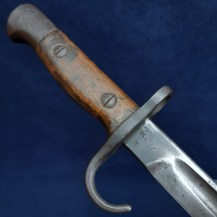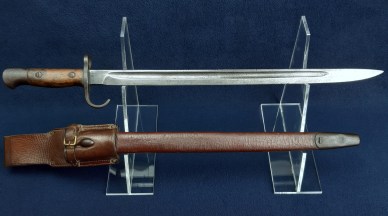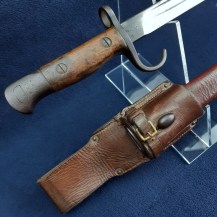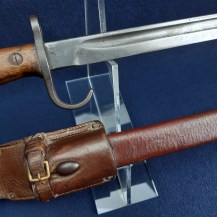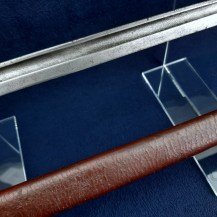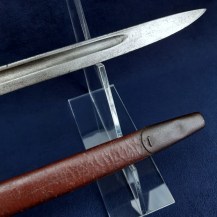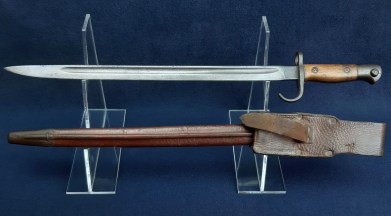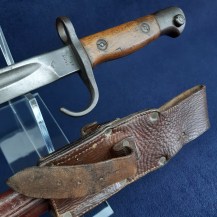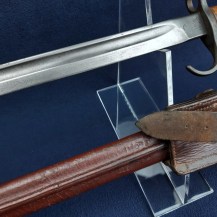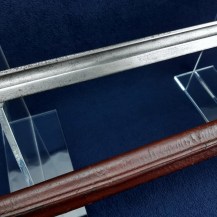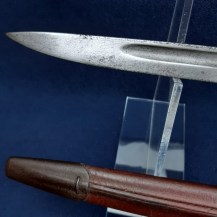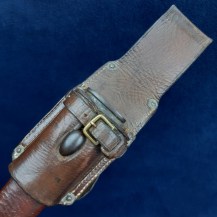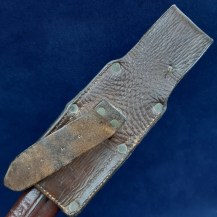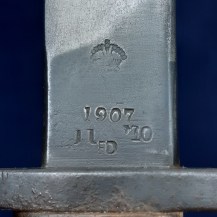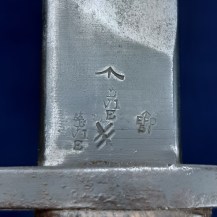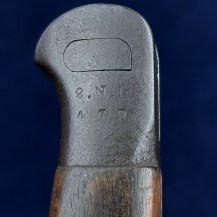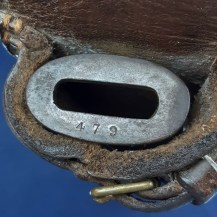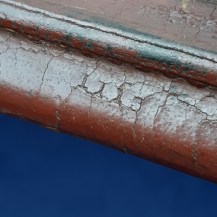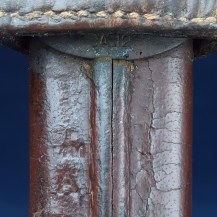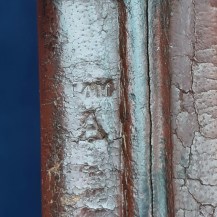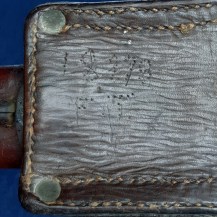British WW1 1907 Pattern Bayonet with Early Hooked Quillon, 2nd Battalion Loyal Lancashire Regiment, East African Campaign
Straight single-fullered knife blade, steel hilt with muzzle ring and distinctive forward-curving lower quillon, wood slab grips secured by two screws, steel beaked pommel with locking button. Brown leather No. 1 Mk 2 scabbard with steel locket & teardrop frog stud and steel chape piece. Brown leather 1914 Pattern frog with buckled retaining strap and rear strap to attach a helve carrier.
This bayonet is still in its original configuration with hooked lower quillon and no oil hole: the quillon was ordered to be removed from new production bayonets in October 1913 and existing examples were often removed by grinding during repair.
The ricasso is stamped on one side with a crown over 1907 (the pattern), 11 ‘10, indicating the manufacture date to be November 1910 and the maker’s mark ‘EFD’ for the Royal Small Arms Factory at Enfield. It is stamped on the other side with a ‘broad arrow’ War Department stores mark, two crown inspection marks with ‘E’ for Enfield, a small stamp made up of another broad arrow over ‘EFD’ over ‘51’, and an ‘X’ indicating that the blade passed a manufacturer’s bending test – this appears to have been double-stamped.
The pommel is stamped with ‘2.N.L.’, indicating the 2nd Battalion, The Loyal North Lancashire Regiment, and the weapon number ‘479’. The scabbard is identically stamped at the throat with ‘479’, confirming that they are an original pair, and next to the staple on the throat and chape pieces with a faint mark that looks like ‘AM’ over ‘OA.12’ – this probably refers to a manufacturer. The leather body of the scabbard is stamped next to the seam with the date ‘13’ as well as ‘1113’, ‘I^M’, (where the ^ is a broad arrow), which I think is an Indian stores mark, and the letter ‘A’. The rear of the frog is faintly, informally marked by poking dots and scratching lines, with what looks like ‘18278’ and ‘F.T.’, which might be a previous owner’s initials and soldier number.
The frog is of the British 1914 Pattern (part of the Infantry Equipment, Pattern 1914 set of leather webbing). It retains the strap on its reverse side which could be used to attach the helve carrier for an entrenching tool.
The 2nd Battalion of the Loyal North Lancashire Regiment was one of only two British battalions deployed to East Africa during the First World War, and the only battalion of British regulars (the other being the newly formed 25th Battalion, Royal Fusiliers). At the outbreak of the war it was deployed to Bangalore, India, joining the 27th (Bangalore) Brigade of the British Indian Army. The Bangalore Brigade was tasked with invading German East Africa via the port of Tanga (in modern-day Tanzania), arriving in November 1914. Despite a substantial numerical advantage this attack, now known as the Battle of Tanga, failed with disproportionate casualties for the invasion force and substantial losses of equipment. The 2nd Battalion had made better progress than most of the British-Indian force but had to withdraw back to their transport ships, which took them to Mombasa.
The German East African forces fought a highly mobile guerilla campaign ranging across what is now Uganda, Kenya, Tanzania, Zambia, Malawi, the Congo, Rwanda, Burundi and Mozambique, under the capable command of Paul von Lettow-Vorbeck. While their strength rose to a peak of 11,000 men at the end of 1915 they remained far outnumbered by British Empire forces, who also had support from Belgian and Portuguese allies. Both sides suffered greatly from supply shortages and disease, and the 2nd Battalion was no exception – it had to be withdrawn from the fight in May 1916 due to ill health among its troops. Early German successes such as Tanga did not translate to long-term advantage, and from 1916 on they were forced out of German East Africa and ground down by the diverse British Empire force, by then under the command of equally capable guerilla fighter Jan Smuts. Their last 1,500 men surrendered in accordance with the Armistice in November 1918.
After recuperating in South Africa the 2nd Battalion was transferred to Egypt in January 1917. It seems to have remained in poor condition and was posted to guard lines of communication. In May 1918 it arrived in France and was attached to the 34th Division, with which it took part in various battles of the Hundred Days Offensive in the closing stages of the war.
The Loyal North Lancashire Regiment became the Loyal Regiment (North Lancashire) from 1921. It was amalgamated with the Lancashire Regiment in 1970 to form the Queen's Lancashire Regiment, which merged with two others in 2006 to form the present-day Duke of Lancaster's Regiment.
There is good reason to think that this bayonet was carried by the 2nd Battalion during their time campaigning in East Africa. We know that before the war the 2nd Battalion was posted to India and had been there since 1910, the year of this bayonet’s manufacture – before that date it had been in Mauritius so it was certainly away from home when the new bayonet was delivered to them. The scabbard is dated 1913, is probably of Indian manufacture but is identically numbered to the bayonet, suggesting they were brought together in the regimental armoury in 1913 while it was stationed there.
This gives the overall picture of pre-war equipment that would have been part of the 2nd Battalion’s stores in India as of 1914, meaning it is very likely to have been taken with them and carried into the Battle of Tanga and subsequent engagements.
The blade is mostly bright, one area of spotted pitting and patination to the spine. The blade retains its blued area at the ricasso. The hilt, exposed tang and pommel have a blued finish. The wood grips have only a couple of dents and some patches of oil staining. The leather scabbard body has light rubbing and surface-level cracking. It is quite flexible, and one should take care to support it once the blade is withdrawn from it. The scabbard fittings are blued, one dent to the chape piece which does not interfere with sheathing and drawing. The frog is in good condition, its leather flexible, some rubbing to the edges on the front side and the retaining strap. One small keyhole-shaped hole to the rear side of the belt loop, just under 1cm long.


